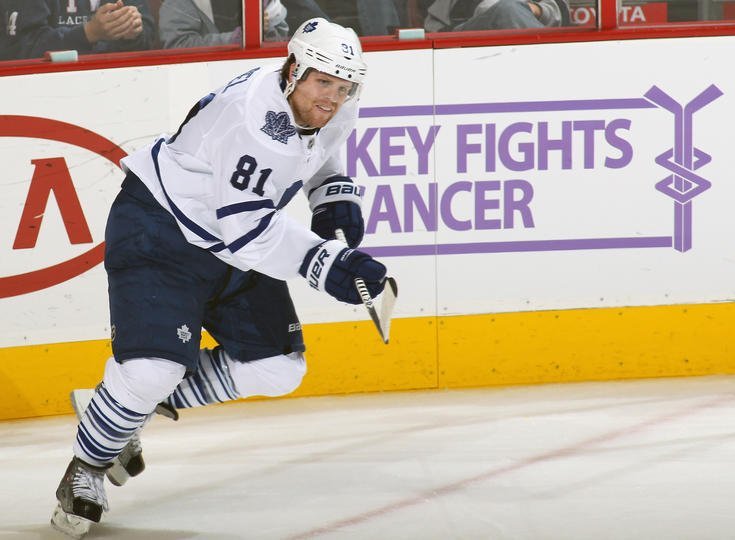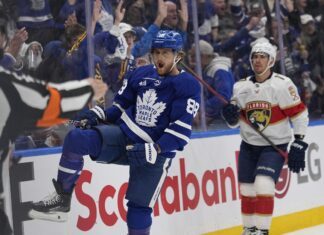This past weekend, Pat Burns was inducted into the Hockey Hall of Fame despite no longer being with us. It served as a stark reminder that we should celebrate the hockey world’s great individuals while they are still here.
This coincides with the unfortunate announcement last week that Bryan Murray’s cancer has spread to his liver and lungs. He’s in stage 4, and there is no stage 5.
In light of these events, I want to take a few minutes to highlight a great and successful hockey mind before it is too late.
Many people often talk about the old guard of hockey GMs and coaches as a group of old boys who all got jobs by doing each other favours. For Bryan Murray, that could not be further from the truth. His first true career after school was as a gym teacher. In fact, he told The Hockey News years ago that his dream job as a child was, “I think a school teacher. From the time I was a real youngster I thought that was sort of my ambition.”
The man with four brothers and five sisters started his hockey career innocently enough as a part-time coach in the CJHL. He also got into the business of buying a local motel, before later investing in Murray’s Sporting Goods (still in business to this day). His success led him to an opportunity to coach the Regina Pats of the WHL.
He told Ottawa At Home, “It was supposed to be just for a year, to see if it was a good fit for me,” adding that his wife, also a teacher, stayed back home to run the business.
A few years later, he led the team to the Memorial Cup. The year after that, he turned pro as an Assistant Coach for Hershey in the AHL.
Murray’s career has been so long and impressive that we could talk about it all day. His first head coaching gig was with the Washington Capitals; when he arrived, the organization had never made the playoffs. They made the playoffs every season of his seven full seasons with the team before his brother, Terry, replaced him behind the bench.
After that, he went to the Red Wings as head coach and GM, which I’m sure a lot of Leafs fans remember. Amid the list of names credited for the Wings’ success of the past 20+ years, Murray is hardly ever one of them. The team he inherited was a 70-point team. The team the Leafs beat finished with 103 points that season. It was Murray that acquired Kris Draper, Paul Coffey and Paul Ysebaert; he drafted Keith Primeau, Darren McCarty, Chris Osgood, and Marty Lapointe.
That was followed by a stint as the Florida Panthers GM, where he won executive of the year in 1996, when the team went to the Cup Finals. In Florida he made one of the biggest hockey robbery trades of all time, exchanging Mark Parrish and Oleg Kvasha for Olli Jokinen and Roberto Luongo. He also brought in Pavel Bure along with Bret Hedican, Brad Ference and a third round pick for Ed Jovanovski, Dave Gagner, Mike Brown, Kevin Weekes and a first round pick.
His next stop – Anaheim — many fans probably know quite well. He promoted Mike Babcock and traded for Peter Sykora, Rob Niedermayer and Steve Thomas before going on a magical run to the Cup Final. He also drafted part of the foundation of the eventual Cup winning roster, signing Dustin Penner as an undrafted UFA and drafting Corey Perry and Ryan Getzlaf (as well as Joffrey Lupul).
And after that was his last stop: Ottawa. Leafs fans know all about his teams that lit Toronto up after the lockout, especially the top line of Heatley-Spezza-Alfredsson. He later moved to GM, making moves like drafting Erik Karlsson, trading for Kyle Turris and Bobby Ryan, as well as signing away Clarke MacArthur.
A man who started his career as a gym teacher, and thought that is what he was destined to do in life, ended up branching out and having an excellent career in professional hockey. In Behind The Moves, Murray is quoted as saying the business has changed from the days where GMs would try to help each other over beers to one all about privacy. In a Hockey News interview, Murray said what he admires most in people is “People you can trust. People who have character. People who, when they give you their word, you know they mean it. It doesn’t have to be a signed document. It’s something we can agree on, whether it be in hockey or otherwise.”
I think many of us can relate what Murray is describing in terms of the type of people we like to associate ourselves with. If there’s one quote that really sticks with me, though, after scanning through Bryan Murray’s profile in Behind The Moves, it is this:
“I started pro with Frank Mathers in Hershey. Frank Mathers was a great athlete. He stayed in Hershey for his whole career and was coach, manager and president. I remember him saying to me, ‘Just remember on the way up, you’re going to meet people on [their] way down, and [eventually] you’re going to be on your way down, so you have to interact with people. Great Advice.”
Good luck in your fight, Bryan Murray. You have had one hell of a career.
Notes
- What interested me about the Sabres shorthanded goal was not the Reimer mistake or the back-checking, or anything like that, it was Phaneuf and Franson together on the power play again. Early in the season I wrote about it, but they struggle to gain the zone because neither of them are strong skaters. The play is either drop it to Kessel or hit JVR on the wall at the blue line and hope JVR can do the rest from there. On that goal, Phaneuf glided up the ice, Kessel was taken away, and Phaneuf skated into a dead end. That was where the whole play swung. Last week, I wrote about sticking with the process over the results, and while the Leafs did go 0/6 on the PP against the Penguins, they had 12 SOG, they were hot coming into that game, and they created opportunities. The puck movement is excellent and the Leafs are dangerous when they win the draw on the power play with Phaneuf and Franson on the ice, but once the puck is cleared it has generally been all downhill from there. At the same time, Rielly and Gardiner are not shooters, and on the power play there was a lot of time spent between the two passing, not even looking at the net.
- One note on Rielly—he has produced SOG at an excellent rate this season, but the scary thing is he has so much more to give. On Pascal Dupuis’ first goal of the game Friday, Rielly had the puck in the home plate region, but he was looking backdoor the entire time, eventually skating himself out of the scoring area before throwing it in front; from there the puck deflected out of the zone, a Penguin player came out of the box, and they later scored. In junior, whenever I caught a game with Rielly playing, he loved the backdoor play, and we still see him doing it a lot. When coaches talk about players playing east-west instead of north-south, that play was a good example of a player taking himself out of a scoring area to attempt a much lower-percentage play.
- David Clarkson is in the top 30 in the NHL in minor penalties taken with 9 through 18 games thus far. Usually physical players that are involved in battles take a lot of penalties — that is not a surprise — but it is the type of penalties he is taking that is troubling: Needless penalties in the offensive zone, of which I count 6 of his 9 penalties have been located (via ESPN’s gamecast tracker). Saturday was an excellent example as the Leafs were buzzing in the Sabres zone stringing opportunities together over a length of time until Clarkson threw a Sabres defender on top of Michal Neuvirth (and then strangely argued the call). The Sabres opened the scoring on that power play.
- The player that leads the league in minor penalties taken? Dion Phaneuf, tied with Steve Downie. The rest of the top five is made up of PK Subban, Evgeni Malkin and Dustin Byfuglien. Most importantly, Phaneuf takes more than he draws, along with 10 other players of the 24 that have dressed for the Leafs this season. Add in that four more players are even in penalties drawn and taken per 60 minutes, and only 9 of 24 have a positive penalty differential (and two of the Leafs top 3 guys of that 9 are Trevor Smith and Sam Carrick). The Leafs are 16th in PP time minus PK time, which is perfectly fine, but for a still-poor overall possession team with a strong power play you want to tilt the scale as much as you can.
- Currently, the Marlies are the worst possession team in the AHL. The team is 5-7-1 through 13 games with a -14 goal differential, putting them 27th in the league. They have a new head coach (Gord Dineen with Derek King as an Associate Coach), and a new GM (Kyle Dubas), while losing their starting goalie and leading scorer from last season. Greg McKegg and Connor Brown are tied for the team lead in scoring with 9 points each in 13 games, and they lead the team in SOG with 34 and 31 respectively; Spencer Abbott has started with 7 points in 10 games, which is a little below the 69 in 64 he put up last season. Dubas did not get a lot of time to shape the roster, and the team has introduced multiple young players to the program in Brown, Nilsson, Loov, Bibeau and Finn, to say nothing of having Petri Kontiola somewhat forced on the team (who is pointless in 10 games with 11 SOG). Not to mention Colton Orr and Frazer McLaren. He did sign two of his own undrafted free agents in Brett Findlay and Patrick Watling, and they have combined for 21 games played, three points and 19 SOG. In recent years the Marlies have been competitive in large part because they acquired middle aged productive AHL veterans such as Brandon Kozun, TJ Brennan, Mark Fraser, Ryan Hamilton, Greg Scott, and so on. The team does have a few of those players now, but I wonder if they will look to acquire some help eventually if this continues.
Quotes
[quote_box_center]He’s always doing extra work in the gym after workouts and then we drive right to the rink and have our skate and then after the skate he’s asking me to do drills with him and then after that I say ‘Santo, what are you doing tonight?’ and he goes ‘I’m just going to go home and shoot some pucks, stickhandle a little bit.’ He’s quite focused. He knows what he wants to do and he knows how he wants to do it and he works hard for it.”
– Morgan Rielly, on Mike Santorelli[/quote_box_center]
Earlier in the year, I told a story about Santorelli practicing back-to-back before staying on the ice with Chris Dennis to work on battle drills. Santorelli has been excellent for the Leafs thus far, driving play, taking some tough assignments, and playing in multiple roles. I think there is definitely a positive to be gleaned from a guy who puts in this much time to hone his craft as an example to others. I’m definitely rooting for the guy.
[quote_box_center]“It’s huge [on backside pressure]. Huge. That’s the biggest part of the game right now… you’ve got to have those numbers coming back so [the other teams] have to play the game differently.”
– Peter Horachek, on the Leafs new system that heavily emphasizes backside pressure.[/quote_box_center]
You’d think it was just invented with the way back checking is talked about now. This has been a vital part of hockey for decades and you can go into any minor hockey rink and hear coaches yelling at 11 year olds to do it.
[quote_box_center]“The one thing I don’t ever hear too much about Burnsie is how fabulous a teacher he was. Back then not many teams played the trap and forechecked a certain way. With Burnsie it was detail, detail, detail. He taught. It was incredible. In that first meeting he said: “this is what is going to happen. We play different than any other team in the league. It is going to take you a little while to get used to the system, eventually what will happen is that it will just be second nature to you .He was exactly right. Once we all caught on we just caught fire.
– Bill Berg, on Pat Burns.[/quote_box_center]
A Leafs team playing with detail? Those were the days.
5 Things I Think I’d Do
- I think I would put Nazem Kadri back with Kessel and Daniel Winnik. It is like groundhog day watching JVR-Bozak-Kessel score a goal but give up one or two in the same game. The line can produce offense, and there is value in putting them together when you are losing, but every game the entire game? Carlyle really wants to die on this hill with a line that can’t breakout and cheats for odd man rushes regularly?
- I think I would run the D like this for a little while and see how it goes: Phaneuf-Franson, Robidas-Rielly, Gardiner-Polak. Both Robidas and Gardiner have been better without the other than with. To my eye, and through my tracking so far, Robidas and Gardiner have really struggled to prevent entries and win puck battles in the corner. Gardiner (who admittedly has an awful CF% with Polak in a small sample) might benefit more from building some familiarity with the physical Polak, who is strong at stepping up in the neutral zone and can halt cycles along the boards. At the same time, Robidas (who has a really strong CF% with Rielly in a small sample size) may benefit from playing with the physically stronger Rielly, who is better at rushing the puck than Gardiner and at evading forechecks.
- I think I would try Holland with JVR if I am breaking up the top line. Holland has played well as of late, but he has not played with true top six forwards very much so far this season (most common wingers being Komarov, Santorelli and Panik). He produced most of his points with Joffrey Lupul and Mason Raymond last season. Holland isn’t a player who can be used as a shutdown C as was attempted against Pittsburgh, but he isn’t defensively weak, either (relatively speaking). It would be nice to see more balance among their top three lines and to see Holland play with one of the more talented players on the team.
- I think, whenever a forward does return, the smart development move is sending down Josh Leivo unless he starts playing more than the 8:15/game he is currently playing, which is a little artificially propped up from playing so much in blowouts. In five games with limited ice time, Leivo has been on for 16 scoring opportunities and 15 against. He’s generally been able to create something once per game and is physically strong enough to engage and win battles. I am optimistic about his future in the league, but he needs ice time now.
- I think, systemically, the Leafs really need to work on their centers swinging lower in the defensive zone and providing more support for the defensemen as well as an outlet option on the breakout. The Leafs have a lot of issues, and that one quick adjustment doesn’t fix them all, but they need to get the cheating out of their game. This series of pictures is a good example of what I am talking about. The Leafs rarely play the game in steps, where they isolate the puck carrier, retrieve the puck, breakout as a unit and move up ice. It’s all offense all the time, and that is a big reason why the Leafs are 27th in shots against.








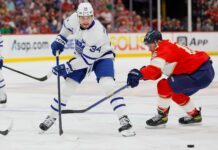

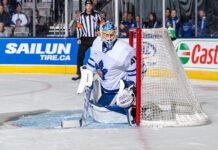


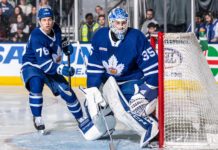
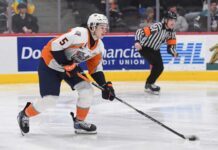
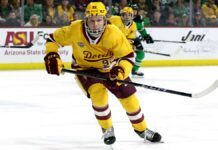

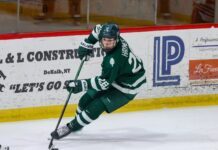
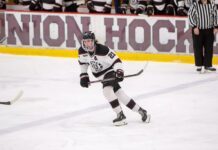


![Two Down, Two to Go for the Maple Leafs – MLHS Podcast EP91 [Now with Video]](https://mapleleafshotstove.com/wp-content/uploads/2025/04/maxresdefault-3-218x150.jpg)


